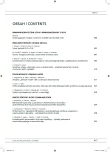Behavioral Disturbances in Patients with Parkinson’sDisease – Screening Patient History by Means of a Questionnaire
Authors:
J. Martinková; P. Valkovič; J. Benetin
Authors‘ workplace:
II. Neurologická klinika LF UK a FNsP Bratislava, Nemocnica akad. L. Dérera, Bratislava
Published in:
Cesk Slov Neurol N 2010; 73/106(5): 534-537
Category:
Short Communication
Overview
Introduction:
Behavioral disturbances associated with Parkinson’s disease include impulse control disorders, punding and dopamine dysregulation syndrome. Despite rising interest in this specific area, behavioral disturbances still remain under-diagnosed. The aim of our study was to verify the effectiveness of a specific questionnaire-based interview in detection of behavioral disturbances in parkinsonian patients.
Subjects and methods:
By means of a specific 8-item questionnaire, we interviewed 80 patients (63 with Parkinson’s disease and 17 with prolactinoma). In Parkinson’s disease patients we also recorded disease phenotype, duration and dopaminergic treatment, as well as any history of anxiety, depression, obsessive-compulsive disorder or panic disorder. Cognitive function state was assessed by means of MMSE and PANDA questionnaires.
Results:
None of prolactinoma patients exhibited behavioral disturbances. Twenty (31.75%) of 63 patients with Parkinson’s disease had a history of some form of behavioral disturbances. Seven of them had more than one behavioral abnormality. All the behavioral disturbances started after initiation of dopaminergic treatment. Patients with behavioral disturbances were younger (61.3 versus 63.3 years; p <0.05), with longer duration of Parkinson’s disease (11.0 versus 6.5 years; p <0.02), and were on higher doses of dopaminergic medication. Furthermore, the group with behavioral disturbances had higher subscores for depression in the PANDA questionnaire (3.8 versus 3.2; p <0.02).
Conclusion:
Our study demonstrates that a specific questionnaire-based interview can significantly facilitate the detection of behavioral disturbances in patients with Parkinson’s disease. The prevalence of these behaviors is undoubtedly higher than may be anticipated in routine clinical examination.
Key words:
behavioral disturbances – Parkinson’s disease – impulse control disorders – punding – dopamine dysregulation syndrome
Sources
1. Giovannoni G, O’Sullivan JD, Turner K, Manson AJ, Lees AJ. Hedonistic homeostatic dysregulation in patients with Parkinson’s disease on dopamine replacement therapies. J Neurol Neurosurg Psychiatry 2000; 68(4): 423–428.
2. Pezzella FR, Colosimo C, Vanacore N, Di Rezze S, Chianese M, Fabbrini G et al. Prevalence and clinical features of hedonistic homeostatic dysregulation in Parkinson’s disease. Mov Disord 2005; 20(1): 77–81.
3. Kanovsky P, Bares M, Pohanka M, Rektor I. Penile erections and hypersexuality induced by pergolide treatment in advanced, fluctuating Parkinson’s disease. J Neurol 2002; 249(1): 112–114.
4. Gescheidt T, Bareš M. Patologické hráčství u pacientů s Parkinsonovou nemocí. Neurol pro praxi 2009; 10(2): 107–110.
5. Christenson GA, Faber RJ, de Zwaan M, Raymond NC, Specker SM, Ekern MD et al. Compulsive buying: descriptive characteristics and psychiatric comorbidity. J Clin Psychiatry 1994; 55(1): 5–11.
6. Weintraub D, Hoops S, Shea JA, Lyons KE, Pahwa R, Driver-Dunckley ED et al. Validation of the questionnaire for impulsive-compulsive disorders in Parkinson’s disease. Mov Disord 2009; 24(10): 1461–1467.
7. Evans AH, Lawrence AD, Potts J, Appel S, Lees AJ. Factors influencing susceptibility to compulsive dopaminergic drug use in Parkinson disease. Neurology 2005; 65(10): 1570–1574.
8. Giladi N, Weitzman N, Schreiber S, Shabtai H, Peretz C. New onset heightened interest or drive for gambling, shopping, eating or sexual activity in patients with Parkinson’s disease: the role of dopamine agonist treatment and age at motor symptoms onset. J Psychopharmacol 2007; 21(5): 501–506.
9. Lim SY, Evans AH, Miyasaki JM. Impulse control and related disorders in Parkinson’s disease: review. Ann NY Acad Sci 2008; 1142: 85–107.
10. Voon V, Hassan K, Zurowski M, Duff-Canning S, de Souza M, Fox S et al. Prospective prevalence of pathologic gambling and medication association in Parkinson disease. Neurology 2006; 66(11): 1750-1752.
11. Kalbe E, Calabrese P, Kohn N, Hilker R, Riedel O, Wittchen HU et al. Screening for cognitive deficits in Parkinson’s disease with the Parkinson neuropsychometric dementia assessment (PANDA) instrument. Parkinsonism Relat Disord 2008; 14(2): 93–101.
Labels
Paediatric neurology Neurosurgery NeurologyArticle was published in
Czech and Slovak Neurology and Neurosurgery

2010 Issue 5
- Memantine Eases Daily Life for Patients and Caregivers
- Metamizole at a Glance and in Practice – Effective Non-Opioid Analgesic for All Ages
- Memantine in Dementia Therapy – Current Findings and Possible Future Applications
- Advances in the Treatment of Myasthenia Gravis on the Horizon
Most read in this issue
- Pudendal Neuralgia – a Case Report
- Development of the PLIF and TLIF Techniques
- Cubital Tunnel Syndrome – a Review of Surgical Treatments and Comparison of their Outcomes
- Gunshot Wounds of the Head and Brain
